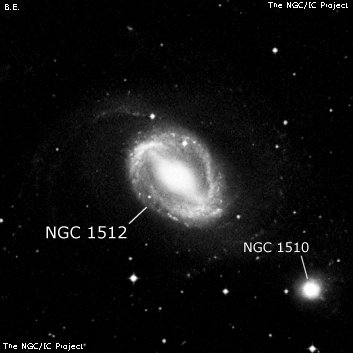
James Dunlop discovered NGC 1512 = D 466 = h2607 on 29 Oct 1826 and described "a small faint round nebula, about 25 arcseconds diameter, a little brighter in the centre: a star of 10th or 12th magnitude preceding the nebula." Dunlop made a single observation and his position is 10' SE of the galaxy (typical error).
John Herschel made 3 observations: On 24 Oct 1835 he logged "bright, large, slightly elongated, pretty suddenly brighter in the middle, 3' diameter; it is just north of a great group of large stars 6, 7 and 8th mag, scattered over two or three fields." On a second sweep he noted "Globular. bright, pretty large, round, 3' diameter. Resolved into stars barely perceptible." Finally, on a third sweep he recorded "B, R, gpmbM." Based on the second description, Herschel identified this object as a globular cluster in the GC.
Joseph Turner sketched NGC 1512 on 5 Dec 1876 with the Great Melbourne Telescope as sharply concentrated with a very small bright nucleus and faint halo. He commented "I cannot make out any distinct appearance of stars, although at times there is a suspicion of sparkling about the center - Indeed it has all the appearance of an ordinary nebula, round and much brighter in the centre. His unpublished lithograph (plate II, figure 11) shows a ring surrounding the core and nucleus. The east side of the halo or ring seems to be connected to the core by a bar.
Based on the GC, Dreyer identified NGC 1512 as a globular in the NGC. The IC 2, though, has a note from DeLisle Stewart "Not a globular cl, but an eF ring nebula". Oh a photograph taken at the Helwan Observatory in Egypt, the galaxy was described in 1921 as a Phi-type (barred-ring) spiral.
300/350mm - 13.1" (2/18/04 - Costa Rica): fairly bright, fairly large, oval 3:2 SW-NE. Sharply concentrated with a bright, 30" core. The tightly bound spiral "ring" was not seen, although there was some brightening at the southwest and northeast ends of the major axis, where the spiral arms emerge from the central bar. Forms a pair with NGC 1510 5' SW.
13.1" (11/29/86): faint, small, slightly elongated. Forms a pair with NGC 1510 5' SW. Very far south for viewing from Northern California.
Notes by Steve Gottlieb